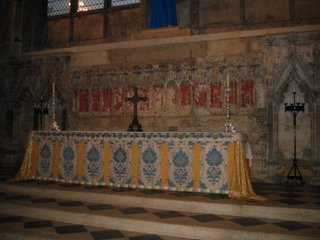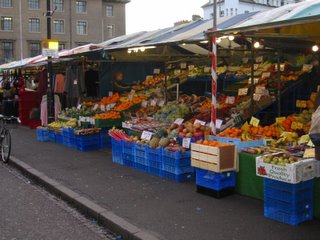First Excursions
Today we made our first two excursions. The first was to the Cambridge Guildhall where the City Council meets. We were met in the lobby by George Swindles, the Sargeant at Mace, who is originally from Belfast, but has lived many years in Cambridge now. This is a picture of the Guildhall as seen from the outdoor market in the center of Cambridge.

 Here are the Council Chambers, with the coat of arms of the city on the banner on the wall.
Here are the Council Chambers, with the coat of arms of the city on the banner on the wall. Here is a close-up of the coat of arms. You can make out the original castle that fortified the city depicted at the top of the seal.
Here is a close-up of the coat of arms. You can make out the original castle that fortified the city depicted at the top of the seal. Here George displays the 12-lb Queen Anne's Mace which he carries at the head of processions and during all official ceremonies. We saw photos on the back wall of the Council Chambers of many royal decrees concerning the city, beginning with one from 1207 that authorized the Cambridge Mayoralty to the most recent decree, from 1951, declaring Cambridge a city. After this information session we met the Mayor himself, John Hipkin, who gave a brief talk about the challenges facing Cambridge today. We were then offered tea and crumpets (of course) in a side chamber and chatted with him.
Here George displays the 12-lb Queen Anne's Mace which he carries at the head of processions and during all official ceremonies. We saw photos on the back wall of the Council Chambers of many royal decrees concerning the city, beginning with one from 1207 that authorized the Cambridge Mayoralty to the most recent decree, from 1951, declaring Cambridge a city. After this information session we met the Mayor himself, John Hipkin, who gave a brief talk about the challenges facing Cambridge today. We were then offered tea and crumpets (of course) in a side chamber and chatted with him. We left the Guildhall at about noon and took our first trip outside of Cambridge, to visit Ely Cathedral (pronounced EE-lee). Ely is a fifteen-minute train ride north of Cambridge (but still within County Cambridgeshire). It is the site of the spectacular cathedral that is the home for the Anglican diocese for Cambridge.

 Here are a few pictures of the back and side of the Cathedral, including a picture of the 'Octagon,' an octagonal-shaped tower above the apse.
Here are a few pictures of the back and side of the Cathedral, including a picture of the 'Octagon,' an octagonal-shaped tower above the apse.  This cathedral sits atop the hill in Ely and can be seen from many miles away; we could see it from the train long before we entered Ely!
This cathedral sits atop the hill in Ely and can be seen from many miles away; we could see it from the train long before we entered Ely!  Just a little history: it was founded as a monastery by St. Etheldreda in 673. The building of the cathedral was started in 1109. Most of the original architecture is Norman, but you can see some Victorian era updates in the "newer" parts.
Just a little history: it was founded as a monastery by St. Etheldreda in 673. The building of the cathedral was started in 1109. Most of the original architecture is Norman, but you can see some Victorian era updates in the "newer" parts.As you might expect, the Cathedral has a number of small chapels throughout. Below are a few of the more ornate ones.
 Here is a picture of the altar in the Lady Chapel (so-called since it was dedicated to Our Lady).
Here is a picture of the altar in the Lady Chapel (so-called since it was dedicated to Our Lady). This is probably what we would call the main altar. It is St. Etheldreda's Chapel and sits behind the 'choir.'
This is probably what we would call the main altar. It is St. Etheldreda's Chapel and sits behind the 'choir.' This is a picture of the entryway to Bishop Alcock's Chapel. The photo doesn't do justice to the detail in the stonework of this screen: highly ornate. Another very visible feature throughout the cathedral is the destruction of the statuary that took place during the Dissolution, when Henry VIII threw out the Catholics and ordered that all vestiges of "popery" be destroyed.
This is a picture of the entryway to Bishop Alcock's Chapel. The photo doesn't do justice to the detail in the stonework of this screen: highly ornate. Another very visible feature throughout the cathedral is the destruction of the statuary that took place during the Dissolution, when Henry VIII threw out the Catholics and ordered that all vestiges of "popery" be destroyed. This collection of medieval buildings along the south side of the cathedral is still in use today. There is a school on the grounds of the original monastery, called Kings School. The students are using some of the original buildings from the monastery. Here are the Prior's Buildings, dating from around 970. The age of this place is astounding! It is said that it costs approximately 3,000 pounds (about $5310) per DAY in upkeep for the cathedral alone.
This collection of medieval buildings along the south side of the cathedral is still in use today. There is a school on the grounds of the original monastery, called Kings School. The students are using some of the original buildings from the monastery. Here are the Prior's Buildings, dating from around 970. The age of this place is astounding! It is said that it costs approximately 3,000 pounds (about $5310) per DAY in upkeep for the cathedral alone.























